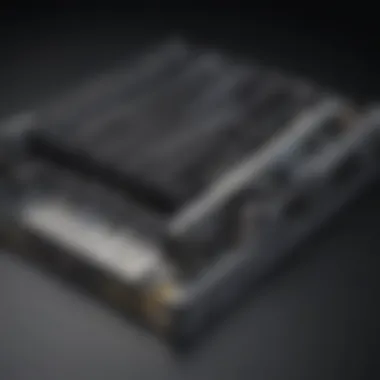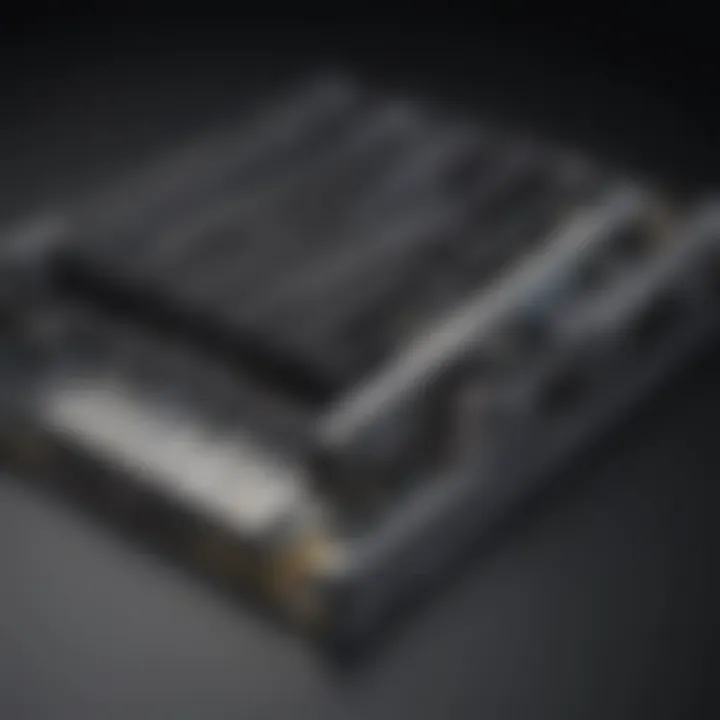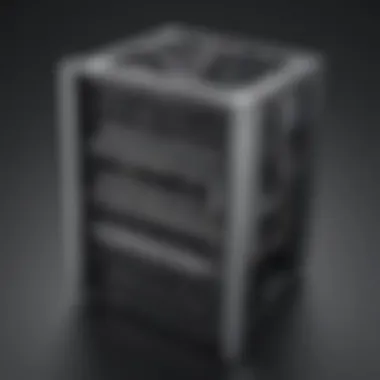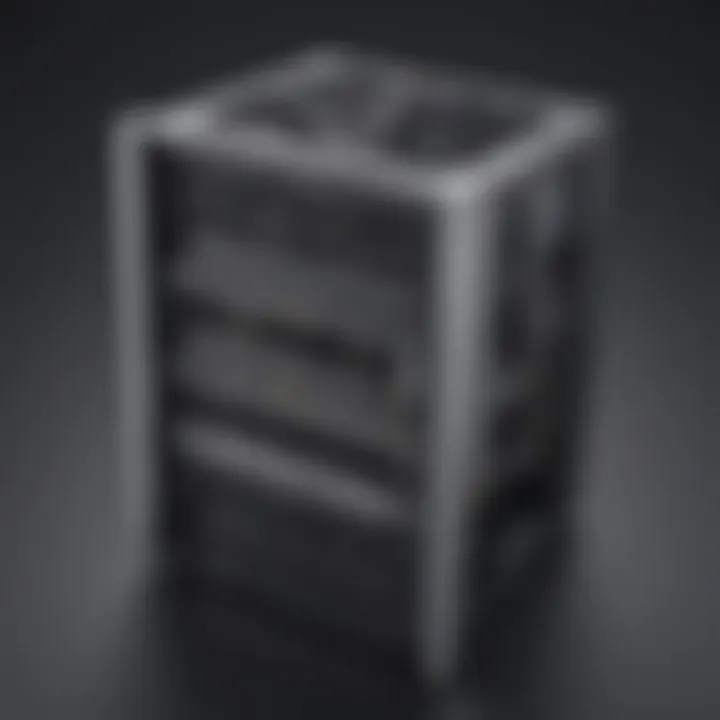Unleashing the Power of OVH GPU Servers for Businesses


Intro
The digital sphere is rapidly evolving, and businesses must adopt technologies that enhance efficiency and performance. Within this landscape, graphic processing units (GPUs) have emerged as critical components in various business applications. OVH, a leader in cloud and dedicated server solutions, offers GPU servers designed to meet the demanding needs of small and medium-sized enterprises.
This section will discuss the capabilities and features of OVH GPU servers. It will elucidate how these servers can significantly impact IT operations and business performance.
Software Overview
Purpose of the Software
OVH GPU servers cater primarily to businesses that require advanced processing power for tasks such as machine learning, deep learning, and high-performance computing. The software framework on these servers is designed to handle complex computations, enabling rapid analysis and data-intensive workflows. Companies in sectors like finance, healthcare, and entertainment stand to gain from deploying GPU resources effectively.
Key Features
OVH GPU servers come equipped with numerous technical specifications that enhance their functionality. Key features include:
- High Memory Bandwidth: The architecture supports large data transfers, essential for applications processing substantial datasets.
- Parallel Computing: Multiple computations can be executed simultaneously, accelerating project delivery timelines.
- Scalability: Businesses can scale resources up or down based on project demands, promoting agility and efficiency.
The flexibility of these features allows businesses to tailor GPU server configurations to specific needs, optimizing performance while managing costs effectively.
Comparison with Competitors
Evaluating OVH GPU servers against other offerings in the market provides crucial insights into their advantages.
Feature-by-Feature Analysis
- NVIDIA Technology: OVH utilizes NVIDIA GPUs, known for superior performance in graphics rendering and AI workloads.
- User-Friendly Management Interface: OVH's management tools streamline server deployment and maintenance, making it accessible for IT professionals of varying expertise.
- Comprehensive Support: OVH provides extensive documentation and support resources, which can be critical for troubleshooting operational issues.
Pricing Comparison
When assessing the financial implications, OVH GPU servers offer competitive pricing models. This can significantly influence decision-making for businesses with budget constraints. Businesses should consider factors such as:
- Hourly vs. Monthly Billing: OVH provides flexible billing options, allowing businesses to choose a plan that fits their usage patterns.
- Cost-Effectiveness: Compared to competitors like Amazon Web Services and Google Cloud, OVH often presents a more affordable option based on similar specifications and performance metrics.
"Cost efficiency alongside high performance is crucial for SMBs looking to leverage advanced computing power."
Overall, OVH GPU servers stand out in their architectural capabilities as well as user-oriented features. Businesses looking to enhance their computational abilities can find a feasible option by exploring OVH's offerings.
Foreword to OVH GPU Servers
When discussing the evolving landscape of technology, OVH GPU servers emerge as a critical focal point for businesses seeking enhanced performance and efficiency. These servers are purpose-built for tasks that require substantial computational power, making them invaluable in a variety of applications. As companies increasingly rely on data-driven insights and complex computing tasks, understanding the role and capabilities of OVH GPU servers becomes essential.
OVH, a prominent player in the servers and cloud computing industry, provides GPU servers that are designed to meet the rigorous demands of modern applications. Their architecture supports high-performance computing, which is particularly relevant for activities involving machine learning, data analysis, and graphics rendering.
The importance of OVH GPU servers lies not only in their technical specifications but also in the benefits they offer to businesses. These benefits include accelerated processing times, improved productivity, and reduced operational costs. Moreover, the scalability of OVH services allows companies to adjust their computing resources based on fluctuating demands. It enables small to medium-sized businesses, as well as entrepreneurs, to access high-end computing resources without the heavy upfront investment usually associated with such technology.
Key considerations about OVH GPU servers also include their integration capabilities within existing IT infrastructure. As businesses look to enhance their operations, the compatibility and support provided by OVH stand out as critical factors in choosing a GPU server. The ability to customize configurations further allows different organizations to tailor the servers according to their specific needs, thus maximizing efficiency.
In summary, OVH GPU servers represent a convergence of power, flexibility, and affordability. As the demand for advanced computational solutions increases, understanding how these servers function within the business ecosystem is vital for informed decision-making. The ensuing sections will delve deeper into GPU technology, the features of OVH GPU servers, and their specific use cases in various business applications.
Understanding GPU Technology
In the context of OVH GPU servers, understanding GPU technology is essential for businesses seeking to leverage advanced computing capabilities. Graphics Processing Units (GPUs) are specialized processors designed to handle complex tasks involving parallel computing more efficiently than traditional CPUs. This section delves into the role of GPUs in computing and their significance for businesses that rely on data-intensive applications.
Defining GPU and Its Role in Computing
A GPU is a highly parallel processor task that excels in managing multiple operations simultaneously. Unlike CPUs, which typically have a few cores optimized for sequential serial processing, GPUs can contain thousands of smaller, efficient cores designed for handling numerous tasks at once. This architectural difference enables GPUs to perform exceptionally well in domains such as graphics rendering, scientific simulations, and machine learning.
Businesses that operate in fields requiring high computational power find GPUs indispensable. They can accelerate workloads significantly, especially in practices like image processing or rendering graphics. In machine learning, for example, the speed of GPUs enables faster training of models, leading to quicker insights and deployment of artificial intelligence solutions.
Comparison: GPU vs. CPU Performance
When comparing GPU and CPU performance, it becomes clear that each has its strengths depending on the application. GPUs are optimized for tasks that can be parallelized, while CPUs are better for tasks requiring more complex decision-making processes. Here is a clear comparison between the two:


- Parallelism: GPUs can handle thousands of threads simultaneously; CPUs generally manage fewer but handle each with more control.
- Performance in Machine Learning: In training deep learning models, GPUs can dramatically reduce processing time by performing large batches of calculations concurrently.
- Energy Efficiency: GPUs are more energy-efficient for certain types of tasks, as their design allows them to achieve better performance per watt.
Despite these advantages, CPUs still hold an edge in tasks that need quick sequential processing or handling of low-latency operations. This characteristic makes the choice between GPU and CPU not merely about performance metrics but rather about the specific workload requirements of a business.
"The right balance between CPU and GPU capabilities can significantly influence the efficiency of computing tasks in any business setting."
In summary, understanding GPU technology, its distinct advantages, and how it contrasts with traditional CPUs is crucial for businesses. This knowledge helps in making informed decisions regarding infrastructure investments, especially in a landscape increasingly reliant on data-intensive applications.
Features of OVH GPU Servers
Understanding the features of OVH GPU servers is crucial for businesses looking to enhance their computational capabilities. These features cater to various business needs, making it essential for IT managers and decision-makers to comprehend their significance. The focus will be on three major aspects: Hardware Specifications, Network and Storage Capabilities, and Security Features.
Hardware Specifications
The hardware specifications of OVH GPU servers are a cornerstone that supports their functionality and performance. OVH offers different configurations, allowing businesses to select the server that best fits their requirements. The hardware options typically include advanced NVIDIA GPUs, such as the Tesla V100, which are designed for intensive computing tasks. These GPUs provide substantial parallel processing power necessary for tasks like machine learning and data analysis.
In addition to powerful GPUs, OVH servers come equipped with substantial amounts of RAM, often reaching 512 GB or more. This memory capacity is vital for handling large datasets, especially in fields like artificial intelligence and complex simulations. Furthermore, OVH ensures that their servers use high-speed SSD storage. This type of storage not only speeds up data access but also increases overall system responsiveness.
Customizability is another key element. Businesses can adapt hardware specifications to specific needs, allowing efficient resource use tailored to business applications.
Network and Storage Capabilities
Network and storage capabilities are critical considerations when selecting a server for business applications. The infrastructure provided by OVH supports high bandwidth, which is essential for applications that require quick data transfer. Typically, OVH servers come with dedicated bandwidth options and provide connectivity to reduce latency, a significant factor in performance when dealing with remote applications.
Storage is equally crucial, featuring options like object storage, which offers scalability and reliable data management. Flexibility in storage solutions ensures businesses can adjust as their data needs grow. Data redundancy measures are also incorporated, enhancing data safety against failures.
This combination of network efficiency and reliable storage solutions ensures that businesses can operate smoothly, maintaining a good balance between processing power and data accessibility.
Security Features
Security is always a major concern for businesses leveraging cloud infrastructure. OVH focuses heavily on this aspect to protect customer data and applications. The security features typically include firewall protection, DDoS mitigation, and regular security audits. Firewalls are crucial in ensuring that only authorized traffic can access the servers.
Benchmarked against industry standards, OVH employs advanced security protocols that enhance data protection on its hardware, including end-to-end encryption options for sensitive data. Regularly updating software and implementing patches is another practice that safeguards against vulnerabilities.
By focusing on strong security measures, OVH enables businesses to proceed with their operations with confidence that their data is secure.
"The combination of robust hardware, efficient networking, and stringent security protocols makes OVH GPU servers a compelling choice for businesses aiming to leverage advanced computing capabilities without compromising on security."
In summary, understanding the features of OVH GPU servers enables businesses to make informed decisions. By focusing on hardware specifications, network and storage capabilities, and security features, companies can better assess how these servers can meet their unique needs.
Use Cases for OVH GPU Servers
The application of OVH GPU servers spans various industries and functions, making them integral for businesses wanting to leverage advanced computing capabilities. The unique characteristics of these servers enable complex processes that can make a significant difference in operational efficiency and output quality. The diverse use cases illustrate the flexibility and power of OVH’s offerings, which can enhance everything from development cycles to analytics.
Machine Learning Applications
Machine learning stands at the forefront of technological innovation. OVH GPU servers provide the essential computational power to process vast amounts of data, enabling businesses to train sophisticated models more efficiently. High-performance GPUs can execute multiple operations concurrently, which is crucial for deep learning tasks that require significant resources. Their algorithms often involve thousands of iterations on large datasets, requiring considerable processing capabilities. This allows companies to develop accurate predictive models, which can lead to better decision-making and improved business strategies.
Some benefits include:
- Faster training times: Compared to traditional CPU-only systems, GPUs can significantly reduce the time to train machine learning models.
- Scalability: OVH GPU servers can easily be scaled according to demand, facilitating both small experiments and large deployments.
- Cost efficiency: By utilizing a pay-as-you-go model, businesses can manage expenses better, only paying for the resources they need during peak usage times.
Video Rendering and CGI
In the realm of video production and computer-generated imagery (CGI), rendering is one of the most resource-intensive tasks. OVH GPU servers provide the necessary horsepower to handle large-scale rendering jobs efficiently. The parallel processing capabilities of GPUs allow them to manage numerous rendering tasks simultaneously. This results in faster turnaround times for projects, which is critical in an industry where deadlines can be very tight.
Key points include:
- Enhanced rendering speed: Time-intensive tasks can be completed much quicker, saving time and resources.
- High-quality output: The computational power of GPUs ensures that even the most complex scenes render with clarity and detail.
- Cost-effective solutions: Renting OVH GPU servers for temporary projects can yield significant savings over investing in high-end internal equipment.
Data Analysis and Visualization
Data-driven decision making is essential for modern businesses. OVH GPU servers excel in handling large datasets that traditional processing might struggle with. They enable rapid analysis and visualization of data, providing businesses with actionable insights almost in real time. Whether it is for business intelligence, customer segmentation, or market analysis, leveraging these servers can greatly enhance data processing capabilities.
Some notable aspects include:


- Real-time data processing: Analyzing and visualizing data as it comes in allows businesses to react immediately to trends or issues.
- Improved data handling: The power of GPUs helps in aggregating and reshaping data effectively.
- Visually impactful insights: Powerful visualization tools supported by GPU acceleration can lead to better presentation and understanding of data trends.
"The ability to process data faster translates into a competitive edge for businesses in today's market."
In summary, OVH GPU servers cater to the needs of small to medium-sized businesses across various domains. Their ability to handle intensive tasks related to machine learning, video rendering, and data analysis make them a valuable resource for any enterprise looking to innovate and streamline operations.
Scalability and Flexibility
Scalability and flexibility are vital aspects of any modern server infrastructure, and OVH GPU servers are no exception. As businesses grow and their computing needs evolve, the ability to seamlessly scale resources is essential. This capability allows organizations to adjust their server capacity based on demand without major disruptions or substantial upfront investments. For small to medium-sized businesses, the ability to respond quickly to changing conditions is a significant competitive advantage.
Flexibility in cloud computing architecture provides users with options to customize their server configurations. This is especially important for industries where workloads can vary greatly, such as machine learning and data analysis. By having the option to easily modify resources, businesses can optimize performance and keep costs in check. Scalability also ensures that as data grows, the servers can accommodate new requirements without necessitating a complete overhaul of the existing infrastructure.
Benefits of Cloud Infrastructure
Cloud infrastructure, especially with OVH GPU servers, provides numerous benefits that directly relate to scalability and flexibility. The main advantages include:
- On-Demand Resources: Users can allocate resources such as GPU, CPU, and storage as needed. This means businesses only pay for what they use and can increase or decrease usage seamlessly.
- Global Reach: OVH's data centers are spread across the globe, which means that businesses can deploy their applications closer to their end-users. This reduces latency and enhances performance for global operations.
- Resilience and Redundancy: Cloud services offer built-in redundancy, reducing the risk of downtime. If one server fails, workloads can be migrated to others without user intervention.
- Ease of Management: Advanced management tools allow IT professionals to monitor usage and performance actively. This helps them better plan for future expansions based on solid metrics.
Cloud infrastructure's inherent flexibility supports businesses in experimenting and evolving without the fear of long-term commitments.
Custom Configuration Options
OVH GPU servers offer various custom configuration options to ensure that users can tailor their environment to match specific business needs. Some key elements include:
- Resource Selection: Users can choose from different types of GPUs based on their workloads. This opens opportunities for tasks such as deep learning or video rendering that require high computational power.
- Operating System Choices: Businesses are not limited to a single operating system. OVH allows users to select from multiple OS options, ensuring compatibility with current software and development environments.
- Networking Features: Administrators can configure network resources, enabling secure connections and high bandwidth for critical applications.
- Scalability Plans: Users can design their growth strategies with OVH’s options for automated scaling. This means applications can expand based on predefined criteria and user activity, maintaining optimal performance.
"Embracing scalability not only empowers a business to grow but also enables them to adapt to market changes effectively."
In summary, the scalability and flexibility offered by OVH GPU servers make them an appealing choice for businesses looking to balance performance and cost efficiency. Leveraging these capabilities allows companies to stay competitive and innovative.
Cost Considerations
Cost considerations play a vital role in the decision-making process for small to medium-sized businesses when evaluating OVH GPU servers. Understanding the pricing dynamics, potential savings and the financial implications of deploying this technology can greatly impact how businesses assess their computing needs. Given that GPU servers come with various pricing models, it is essential to analyze which option aligns best with the specific requirements of a business. Optimizing cost efficiency is crucial not only for preserving capital but also for maximizing return on investment over time.
Pricing Models Explained
OVH offers several pricing models tailored to different business needs. Key factors in these models include:
- Pay-as-you-go: This model allows businesses to only pay for their GPU server usage, making it suitable for projects with variable workloads. It provides flexibility and helps avoid unexpected costs.
- Monthly subscriptions: For businesses that require consistent access to GPU resources, a monthly subscription can be more economical. This model often includes dedicated resources, ensuring reliability and improved performance.
- Reserved instances: This option typically offers significant discounts for customers who can commit to using servers over an extended period. It is ideal for long-term projects or ongoing operations.
Understanding these models enables businesses to choose the most cost-effective solution for their specific use case. It is important for businesses to review their workload patterns and project timelines carefully before making a decision.
Comparative Cost Analysis with Competitors
When considering GPU servers, it is valuable to conduct a cost analysis comparing OVH to other cloud service providers like Amazon Web Services or Google Cloud. Factors to consider in this analysis include:
- Base Pricing: Compare the starting prices for similar configurations across providers. OVH often provides competitive pricing, especially for high-performance GPU options.
- Additional Costs: Look for hidden fees, such as data transfer fees, storage costs, and support charges. These can significantly affect overall expenses.
- Performance vs. Price: Evaluate the performance capabilities for the cost. Analyzing metrics such as processing speed and data throughput can indicate value beyond just the monetary cost.
- Long-term Commitments: Some providers incentivize long-term commitments with lower prices. Evaluating contract lengths and potential savings over time can influence your decision.
"The choice of the right GPU server is not merely about the upfront costs. It requires a thorough understanding of long-term performance and efficiency metrics to ensure sustainable ROI."
By closely analyzing these factors, businesses can make more informed choices and potentially save significant costs over time.
User Experience and Feedback
User experience and feedback are critical components when evaluating any technological solution. In the context of OVH GPU servers, user feedback offers insights into not only the operational efficiency but also the real-world applications of these servers. Understanding users' experiences can guide businesses in making informed decisions about adopting these technologies.
Feedback from actual users highlights various aspects of performance, which can directly influence operational decisions. Metrics derived from these users' experiences can provide benchmarks for potential performance amid different workloads. Users frequently report their satisfaction levels about reliability, speed, and ease of integration within their existing infrastructures.
Performance Metrics from Users
Gathering performance metrics from users reveals how OVH GPU servers operate under real conditions. These metrics, often shared on IT forums or direct surveys, indicate how businesses utilize these servers to handle intensive tasks. Some critical performance areas include:
- Processing Speed: Many users note significant enhancements in processing time for tasks such as 3D rendering and machine learning. These improvements allow for quicker decision-making in business applications.
- Uptime Reliability: Users have reported high levels of uptime, a crucial metric for any business relying on consistent server performance.
- Scalability: Reviewers frequently mention how OVH GPU servers adapt to increasing demands without significant downtime or performance drops.
Regularly monitoring such user-reported metrics can equip IT managers with essential data. This information proves invaluable when planning for capacity or determining whether to scale operations.


Common Challenges Faced
While many users appreciate the capabilities of OVH GPU servers, there are challenges noted in various discussions and feedback channels. Addressing these issues can enhance user satisfaction and overall experience. Common challenges include:
- Configuration Complexity: New users sometimes find the initial setup and configuration challenging. Documentation may not always meet the specific needs of everyone, leading to confusion during deployment.
- Support Responsiveness: Some users have mentioned that customer support could be more responsive, particularly during peak times when many businesses are active.
- Costs vs. Performance Tradeoff: Evaluating the cost-effectiveness of OVH GPU servers can be tricky. Businesses must analyze whether the performance gained justifies the expenses involved.
"Understanding the challenges faced by peers in the industry can help you prepare for similar situations."
Incorporating user feedback into strategy development can highlight areas requiring improvement. By addressing common challenges, OVH can enhance their service, ultimately benefitting all users.
Potential Limitations
When businesses consider integrating OVH GPU servers into their operations, it is vital to understand potential limitations. While these servers offer advanced computing capabilities, recognizing their constraints can guide informed decision-making. An in-depth evaluation of both hardware and service aspects reveals critical factors that may impact a company's effectiveness and adaptability.
Hardware Constraints
A primary consideration when using OVH GPU servers is hardware constraints. Although OVH provides a range of GPU options, the available configurations might not meet every business's needs. For instance, some enterprises may require specific GPUs optimized for certain applications. Not all GPU models excel at all tasks. Therefore, it is essential to align selected GPU types with their intended use cases.
Common hardware limitations include:
- Physical Size: Limited physical space in data centers may restrict the number of servers a business can deploy.
- Compatibility Issues: Existing infrastructure may not integrate seamlessly with OVH servers, leading to inefficiencies.
- Upgrade Challenges: As technology advances, upgrading hardware can be complex and may require significant investment.
These hardware constraints demand careful planning and consideration, as the impact can hinder performance and scalability over time.
Service Restrictions
Another aspect that organizations must account for is the service restrictions associated with OVH GPU servers. Despite the powerful capabilities these servers offer, they come with certain limitations that could affect user experience and project deployment.
Key service restrictions include:
- Limited Support Hours: Depending on regions and service plans, support availability may vary, potentially delaying troubleshooting and response times.
- Resource Allocation: Users might face constraints in resource allocation, leading to potential slow-downs during peak usage.
- Contract Flexibility: Not all contracts offer flexible terms, which can restrict a company's ability to scale or adapt services as business needs change.
Understanding these service limitations is crucial for businesses aiming to leverage OVH GPU servers successfully. Each restriction can play a significant role in long-term planning and decision-making, influencing whether the investment in such technology aligns with their operational goals.
In summary, while OVH GPU servers provide exciting capabilities, recognizing and addressing their potential limitations is essential for optimizing their use within business contexts.
Considering these elements ensures that companies can seamlessly integrate advanced computing solutions without encountering unexpected obstacles.
Future Trends in GPU Servers
The landscape of GPU servers is rapidly changing. As industries increasingly rely on advanced computing, understanding future trends becomes crucial for businesses. This section explores key advancements and their implications for operations, particularly in small to medium-sized enterprises.
Advancements in GPU Technology
Recent advancements in GPU technology are shaping the capabilities of GPU servers. Improved architectures, like Nvidia's Ampere and AMD's RDNA, provide significant boosts in efficiency and processing power. These developments facilitate faster data processing and more complex computations.
Continuous integration of AI and machine learning capabilities into GPUs enhances their effectiveness in data-driven tasks. With Tensor Cores and AI-specific features, organizations can now accelerate workloads like never before. The evolution of memory technology, such as High Bandwidth Memory (HBM), also enhances data transfer rates. This results in quicker processing and allows for more intensive applications.
Another important trend is the shift towards multi-GPU systems. Businesses can utilize multiple GPUs to scale processing power dynamically. This scalability is essential for handling larger datasets, leading to improved performance in applications like image processing and 3D rendering.
Impact on Business Operations
The impact of these advancements on business operations is profound. As GPU servers become more powerful and efficient, organizations can execute complex tasks with reduced time and cost. For instance, in sectors like healthcare and finance, faster analytical capabilities can lead to better decision-making.
- Enhanced Analytics: Companies are leveraging GPUs for real-time data analytics. This ability to process large datasets swiftly promotes a data-driven culture, enabling rapid insights and actions.
- Improved Productivity: With faster processing times, employees can devote more time to strategic tasks rather than waiting for computer systems to catch up. This shift allows for increased focus on innovation.
- Cost Efficiency: The evolution of GPU technology often leads to reduced costs per computation. Over time, organizations notice savings that can be reinvested into research and development or other key areas.
"Leveraging cutting-edge GPU technology not only improves operational efficiency but also positions businesses competitively in the market."
Finale and Recommendations
In evaluating the implementation of OVH GPU servers, it is crucial to summarize the findings from the previous sections and delineate practical recommendations for businesses. The conclusions drawn from the exploration of OVH GPU servers underscore their significant role in enhancing computational effectiveness, particularly in demanding environments such as machine learning and data visualization. By embracing this technology, organizations can streamline operations, improve processing times, and ultimately increase productivity. The benefits include better resource allocation, scalability, and flexibility which position businesses to adapt to changing needs and conditions.
Key Takeaways for Businesses
- Optimized Performance: Organizations should recognize that OVH GPU servers can dramatically improve processing power, especially for tasks that are computationally intense.
- Cost-Effectiveness: By utilizing the cloud infrastructure provided by OVH, businesses can reduce capital expenses linked to hardware procurement and maintenance.
- Scalability: Companies can easily scale their resources up or down based on demand, maximizing efficiency without unnecessary spending.
- Diverse Applications: OVH GPU servers are versatile, applicable in fields ranging from machine learning to video rendering, ensuring that various business needs can be met effectively.
- User Feedback: Listening to the user experience offers valuable insights that may guide future improvements in server performance and reliability.
Steps to Implement OVH GPU Servers
- Evaluate Business Needs: Companies must first assess their specific computational requirements and decide how deploying GPU servers fits into their strategy.
- Conduct Cost Analysis: Understanding the pricing models available from OVH helps in budgeting appropriately. Organizations should consider the total cost of ownership and any potential savings from operational efficiencies.
- Choose Configuration: Businesses should select the appropriate server configuration that not only aligns with their current needs but also anticipates future growth.
- Consult Technical Resources: Utilizing OVH’s technical documentation and support can facilitate effective setup and integration into existing systems.
- Training for Staff: Ensuring that your IT team is adequately trained on utilizing OVH GPU servers will maximize effectiveness in leveraging the technology.
- Monitor and Optimize: After deployment, continuous monitoring of performance metrics is essential. Regularly reviewing and optimizing server performance will lead to sustained benefits.
Adopting OVH GPU servers is a significant move for many organizations, aligning technological advancements with business goals. A thoughtful approach increases the likelihood of successful integration and maximum return on investment.



